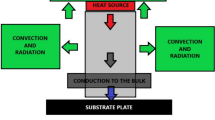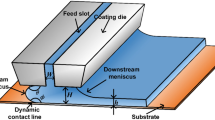Abstract
A twisted channel self-bending shunting die, a vertical shunting die, and a symmetrical streamlined shunting die were designed. The plate extrusions of these dies were simulated and experimented with. The experimental results show that the actual metal flow is consistent with it in the simulation. The results of the simulation show that the leftward bending plate is extruded out by the twisted channel self-bending shunting die, and the straight plate is extruded out by the other dies. The data for the welding path in the extrusion process of the three shunting dies were extracted, and the J values of the welding criterion were calculated. The longer the weld stability height distance above the J value, the wider the stable weld formation interval, the better the weld quality. The order of weld quality among the three dies is that vertical shunting die < symmetrical streamlined shunting die < twisted channel self-bending shunting die. The symmetrical streamlined shunting die and the twisted channel self-bending shunting die were simulated at different extrusion speeds, the results show that the greater the extrusion speed, the shorter the distance of the stable weld height above the junction value J, and the worse the weld quality of the shunting dies.
















Similar content being viewed by others
Availability of data and materials
All data generated or analyzed during this study are included in this article.
References
Xiao H, Liu J, Zhang S, Zhang XG, Wang Q (2011) Research on a new process: warm tension-rotation bending of AZ31 extruded profile. Adv Sci Lett 4(3):1002–1006. https://doi.org/10.1166/asl.2011.1322
Wang X, Sun K, Liu Z et al (2021) A novel protection-type porthole die for manufacturing multi-cavity and thin-walled extrusion profile: numerical simulation, optimization design, and experimental validation. Int J Adv Manuf Technol 116:1691–1706. https://doi.org/10.1007/s00170-021-07582-6
Liu G, Zhou J, Duszczyk J (2008) FE analysis of metal flow and weld seam formation in a porthole die during the extrusion of a magnesium alloy into a square tube and the effect of ram speed on weld strength. J Mater Process Tech 200(1–3):185–198. https://doi.org/10.1016/j.jmatprotec.2007.09.032
Lee JM, Kim BM, Kang CG (2005) Effects of chamber shapes of porthole die on elastic deformation and extrusion process in condenser tube extrusion. Mater Design 26(4):327–336. https://doi.org/10.1016/j.matdes.2004.06.007
Güley V, Güzel A, Jäger A, Khalifa NB, Tekkaya AE, Misiolek WZ (2013) Effect of die design on the welding quality during solid state recycling of AA6060 chips by hot extrusion. Mater Sci Eng A 574:163–175. https://doi.org/10.1016/j.msea.2013.03.010
Yu JQ, Zhao GQ, Chen L (2016) Investigation of interface evolution, microstructure and mechanical properties of solid-state bonding seams in hot extrusion process of aluminum alloy profiles. J Mater Process Tech 230:153–166. https://doi.org/10.1016/j.jmatprotec.2015.11.020
Yu JQ, Zhao GQ, Chen L (2016) Analysis of longitudinal weld seam defects and investigation of solid-state bonding criteria in porthole die extrusion process of aluminum alloy profiles. J Mater Process Tech 237:31–47. https://doi.org/10.1016/j.jmatprotec.2016.05.024
Buffa G, Pellegrino S, Fratini L (2014) Analytical bonding criteria for joint integrity prediction in friction stir welding of aluminum alloys. J Mater Process Tech 214(10):2102–2111. https://doi.org/10.1016/j.jmatprotec.2014.02.014
Lu X, Zhang CS, Zhao GQ, Guan Y, Chen L, Gao AJ (2016) State-of-the-art of extrusion welding and proposal of a method to evaluate quantitatively welding quality during three-dimensional extrusion process. Mater Design 89:737–748. https://doi.org/10.1016/j.matdes.2015.11.070
Plata M, Piwnik J (2000) Theoretical and experimental analysis of seam weld formation in hot extrusion of almninum alloys. Proc Int Alum Extrusion Technol Semin P 205–212
Donati L, Tomesani L (2004) The prediction of seam welds quality in aluminium extrusion. J Mater Process Tech 153(22):366–373. https://doi.org/10.1016/j.jmatprotec.2004.04.215
Liu Z, Li L, Yi J et al (2017) Influence of extrusion speed on the seam weld quality in the porthole die extrusion of AZ31 magnesium alloy tube. Int J Adv Manuf Technol 92:1039–1052. https://doi.org/10.1007/s00170-017-0200-x
Bai SW, Fang G, Zhou J (2019) Integrated physical and numerical simulations of weld seam formation during extrusion of magnesium alloy. J Mater Process Tech 266:82–95. https://doi.org/10.1016/j.jmatprotec.2018.10.025
Younas N, Chalal H, Abed-Meraim F (2020) Finite element simulation of sheet metal forming processes using non-quadratic anisotropic plasticity models and solid-shell finite elements. Procedia Manuf 47:1416–1423. https://doi.org/10.1016/j.promfg.2020.04.302
Gordon W, Van Tyne C, Moon Y (2007) Axisymmetric extrusion through adaptable dies - part 2: comparison of velocity fields. Int J Mech Sci 49(1):96–103. https://doi.org/10.1016/j.ijmecsci.2006.07.012
Gordon W, Van Tyne C, Moon Y (2007) Axisymmetric extrusion through adaptable dies - part 3: minimum pressure streamlined die shapes. Int J Mech Sci 49:104–115. https://doi.org/10.1016/j.ijmecsci.2006.07.013
Rejaeian M, Aghaie-Khafri M (2015) A new approach for modeling of streamlined die operations based on a non-quadratic stream function. Int J Mech Sci 101–102:376–386. https://doi.org/10.1016/j.ijmecsci.2015.08.011
Min FL, Liu HP, Zhu GM, Chang Z, Guo NN, Song JB (2021) The streamlined design of self-bending extrusion die. Int J Adv Manuf Technol. https://doi.org/10.1007/s00170-021-06760-w
Foydl A, Segatori A, Khalifa NB (2013) Grain size evolution simulation in aluminium alloys AA 6082 and AA 7020 during hot forward extrusion process. J Mater Sci Technol 29(1):100–110. https://doi.org/10.1179/1743284712Y.0000000132
Min FL, Liu HP, Zhu GM, Chang Z, Gao XJ, Yue BW, Guo NN, Zhai XQ (2021) Self-bending extrusion molding of distorted channels. J Mech Sci Technol 35:1945–1953. https://doi.org/10.1007/s12206-021-0412-8
Sohn Y (2004) 13 - Diffusion in metals [M]. In: Totemeier WFGC (ed) Smithells Metals Reference Book, 8th edn. Butterworth-Heinemann, Oxford, pp 1–120
Run H, Xia JC, Li ZG, Dong XH, Yang GT, He CH (2002) Effect of process parameters on the extrusion deformation law of aluminum profiles. Chin J Nonferrous Met 12(6):1154–1161
Li SK, Li LX, Liu ZW, Wang G (2017) Effect of extrusion speed on welding strength of 6063 aluminum alloy tubes. Chin J Nonferrous Met 27(9):1775–1784. https://doi.org/10.19476/j.ysxb.1004.0609.2017.09.03
Valberg H, Loeken T, Hval M, Nyhus B, Thaulow C (1995) Extrusion of hollow profles with a gas pocket behind the bridge. Int J Mater Prod Tech 10:222–267. https://doi.org/10.1504/IJMPT.1995.036453
Valberg H (2002) Extrusion welding in aluminium extrusion. Int J Mater Prod Tech 17:497–556. https://doi.org/10.1504/IJMPT.2002.001317
Funding
This work was supported by the Natural Science Foundation of Shandong Province [Project Number ZR2017MEE036] and Zibo City School City Integration Development Project [Project Number 2017ZBXC205]. Natural Science Foundation of Shandong Province,ZR2017MEE036,Guangming Zhu,Zibo City School City Integration Development Project,2017ZBXC205,Guangming Zhu
Author information
Authors and Affiliations
Contributions
Huiping Liu: software, validation, writing–original draft, writing–review, and editing; Fanlei Min: conceptualization, methodology, software, and writing–original draft; Guangming Zhu: resources and supervision; Zheng Chang: resources and supervision; Nana Guo, Bowen Yue, Xujie Gao, and Zongshen Wang: investigation. All authors read and approved the final manuscript.
Corresponding authors
Ethics declarations
Ethics approval
Not applicable.
Consent to participate
Not applicable.
Consent for publication
Not applicable.
Competing interests
The authors declare no competing interests.
Additional information
Publisher's Note
Springer Nature remains neutral with regard to jurisdictional claims in published maps and institutional affiliations.
Huiping Liu and Fanlei Min are contributes equally to this work.
Rights and permissions
About this article
Cite this article
Liu, H., Min, F., Yue, B. et al. Self-bending extrusion welding behavior of streamlined function die. Int J Adv Manuf Technol 119, 3065–3076 (2022). https://doi.org/10.1007/s00170-021-08552-8
Received:
Accepted:
Published:
Issue Date:
DOI: https://doi.org/10.1007/s00170-021-08552-8




